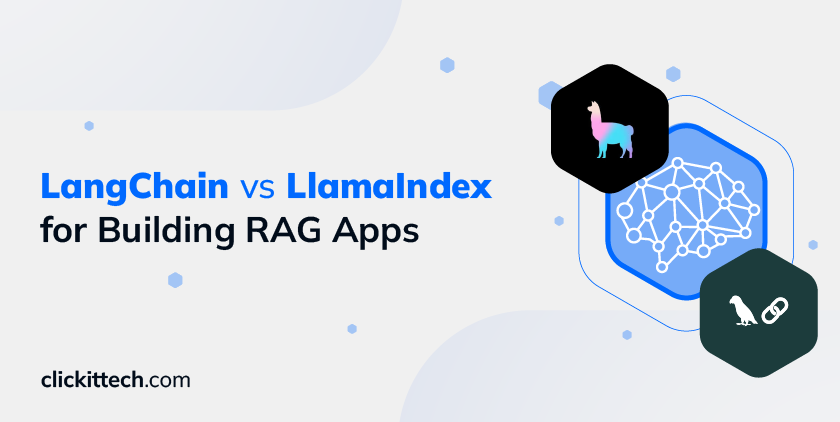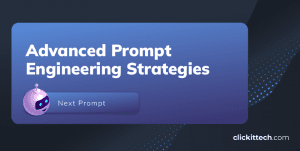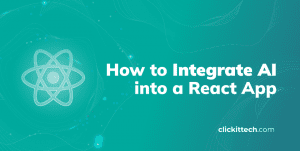AI developers, gather here. You’ve probably come across the debate between LangChain vs LlamaIndex for RAG applications. This discussion is becoming more relevant because generative AI tools and search engines are now being used to tackle complex questions and queries.
So, when working with language models, you must remember the need for retrieval-augmented generation (RAG), which allows your AI to deliver quick, humanlike responses by accessing vast amounts of data.
If any part of this is confusing, we’ll pull each apart, explain, and connect all the dots at the end of the article. First off, let’s start with what RAG is.
What is RAG?
Retrieval-augmented generation (RAG) enhances the relevance and quality of outputs from large language models (LLMs) by combining generative capabilities with external information retrieval.
First, it references relevant information or documents from an external knowledge base. This retrieved context is provided to a generative model to produce context-informed responses and answers.
In simple words, RAG allows an AI to actively seek out updated or particular information from external sources, rather than relying solely on the knowledge “baked” into it from its training data. So, because you don’t have to always re-train your model, this technique is inexpensive to make your AI model’s output relevant, up-to-date, and accurate across a wide range of applications.
Now that we’ve described RAG, let’s investigate some frameworks that can help you build a RAG-powered application: LangChain and LlamaIndex.
What is LangChain?
LangChain is an open-source framework that helps developers create complex applications with language models. It streamlines tasks such as building chatbots, summarising large volumes of text, or developing AI tools that combine reasoning with current information retrieval. Its plethora of reusable components greatly simplifies and accelerates complex AI workflow development.
Benefits of LangChain in RAG applications
LangChain offers many tools and features that enhance flexibility and usability, making it well-suited for diverse applications.
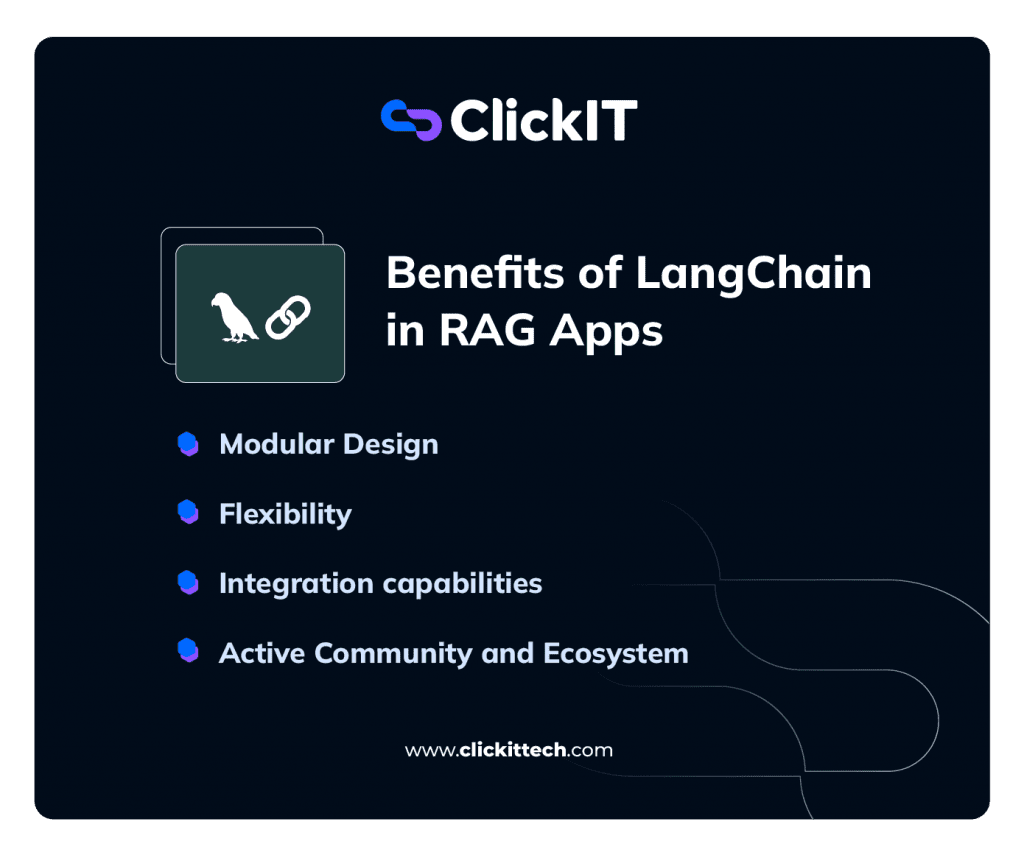
Modular Design
Firstly, LangChain’s modular and interchangeable components for prompts, data retrieval, and model interaction make designing, configuring, and scaling RAG applications easy.
Flexibility
Langchain is also quite flexible. For example, it supports keyword, vector, and custom searches, enabling developers to use various retrieval methods depending on their needs. Because it’s highly extensible, developers can adapt LangChain to meet specific requirements, such as domain-specific language models or specialized data sources.
Integration
In addition, LangChain has excellent integration capabilities. It allows models to use tools like calculators or search engines for extra tasks and works well with cloud platforms.
Community and Ecosystem
As an open-source project, LangChain benefits from an active community. Regular updates and community-contributed plugins expand its features and improve stability. As well as providing ample documentation, community tutorials, and resources.

Disadvantages of LangChain in RAG applications
It’s essential to understand the limitations of frameworks before we use them. So, here are some shortfalls of LangChain.
Problems with Data Ingestion
Preparing and integrating data for RAG applications can be a snag, especially when working with unstructured or vast amounts of information.
Its Dependency on External Libraries
LangChain uses external tools and libraries for retrieval and processing. If these libraries are incompatible, it may affect the application’s performance or introduce maintenance overhead.
Steep Learning Curve
LangChain’s flexibility and modularity are complicated. Hence, workflows can be difficult for new users to understand and set up.
What is LlamaIndex?
LlamaIndex (formerly known as GPT Index) is an open-source library that connects LLMs to external data sources such as databases, documents, and APIs. It offers a straightforward way to build RAG applications by indexing data and integrating popular LLMs like GPT and LLaMA.
Benefits of LlamaIndex in RAG applications
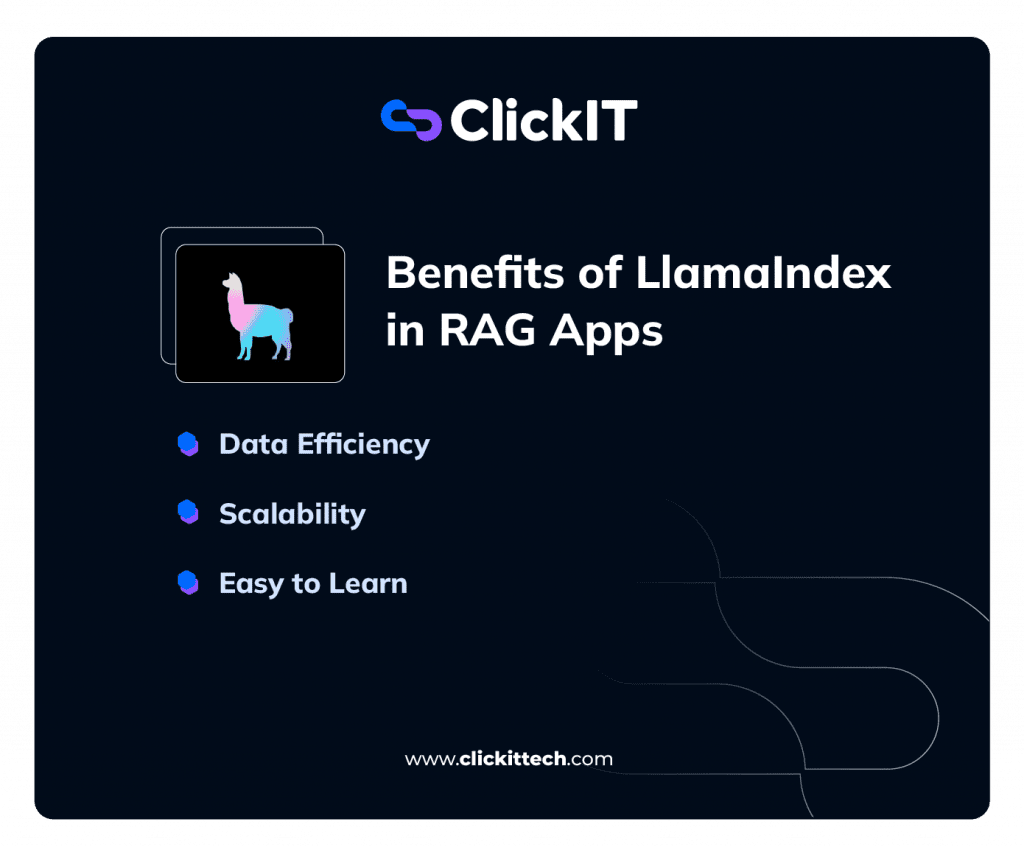
Data Efficiency
LlamaIndex helps to organize and index data. This is useful when working with massive datasets or complicated queries in RAG applications.
Scalability
LlamaIndex is useful when scaling your applications to meet increasing data and user demands. It enables efficient handling of high data loads, making it an important consideration when comparing LangChain vs. LlamaIndex for RAG applications in organizations with growing needs.
Easy to Learn
LlamaIndex’s design is straightforward and user-friendly. You can use it even as a beginner.
Limitations of LlamaIndex in RAG applications
Although LlamaIndex is a valuable tool for RAG applications, some limitations require careful design or more resources:
Indexing speed
LlamaIndex might be resource-intensive when dealing with massive datasets during the indexing step. Unfortunately, this can delay application setup.
Complex Integration
Lastly, even though LlamaIndex supports a variety of data sources, integrating it with specific systems, APIs, or tools can be problematic. It may require extra effort, technical expertise, or custom solutions for smooth integration.
Read our blog AI vs Machine Learning to understand their difference.
LangChain vs LlamaIndex for RAG applications: Similarities
When it comes to LangChain vs LlamaIndex for building RAG applications, you have to know their unique features and key similarities, which are:
Agents
LangChain and LlamaIndex support agents (that handle tasks and make decisions) in RAG applications.Read our blog on AI Agents for Business to learn more about this innovation.
Integration with LLMs
Whether using open-source models like LLaMA or large language models (LLMs), developers can select the best model for their unique requirements because of the flexibility.
Extensibility
LangChain and LlamaIndex are flexible for various applications since they are made to be reusable.
How to Decide Between LangChain vs LlamaIndex for Building RAG Applications
We know it can be hard to choose between LangChain vs LlamaIndex for RAG systems, but we have good news! You don’t always have to pick one because they can work together. Let’s explore how to decide between them or combine their capabilities:
Project Size
LlamaIndex is easy to set up and easy to use, while Langchain’s modular design can handle complex workflows better. If you wish to combine these tools, you can start with the small projects using LlamaIndex and use Langchain for the large projects.
Data Complexity
LlamaIndex helps with organized and simple data, while LangChain provides custom pipelines and advanced workflow. When combined, LlamaIndex can be used for retrieval, while LangChain can be used for processing.
Budget Constraints
LlamaIndex is lightweight and budget-friendly, while LangChain is more flexible but requires more resources anyway.
Team Expertise
LlamaIndex is easier to learn, while LangChain needs experienced developers because of its complex setups. Therefore, you can start with LlamaIndex, but you will have to switch to LangChain as your skill grows.
Our team has the best expertise to deliver top AI development services
Community Support
LlamaIndex has a small community, while LangChain has a larger and more active community for troubleshooting. You can choose a tool based on the level of direction you need.
Your project will likely determine which tool you should choose between LangChain vs LlamaIndex for RAG. Do you need a fast and straightforward setup? LlamaIndex is better. If you’re working with complex workflows, choose LangChain.
Read our blog about the best AI Tools for software development

FAQs about LangChain vs LlamaIndex for Building RAG Apps
LangChain is excellent for building complex workflows, while LlamaIndex is better suited to efficient data indexing and retrieval.
Think about your project size, data complexity, budget, and team skills. LlamaIndex works great for simple projects, while LangChain is better for complex setups.
Yes, just start with LlamaIndex for the easy setup and switch to LangChain as your project gets bigger.
If you need advanced retrieval and complex interactions, like chatbots or code navigation tools, LangChain is better. For fast, document-focused RAG systems, like knowledge management or internal search, go with LlamaIndex.
Yes, both LangChain and Llamaindex are suitable for production-ready RAG apps. LlamaIndex offers a simpler interface, while LangChain provides more complexity, which you’d expect since it’s more general-purpose and for diverse applications.

